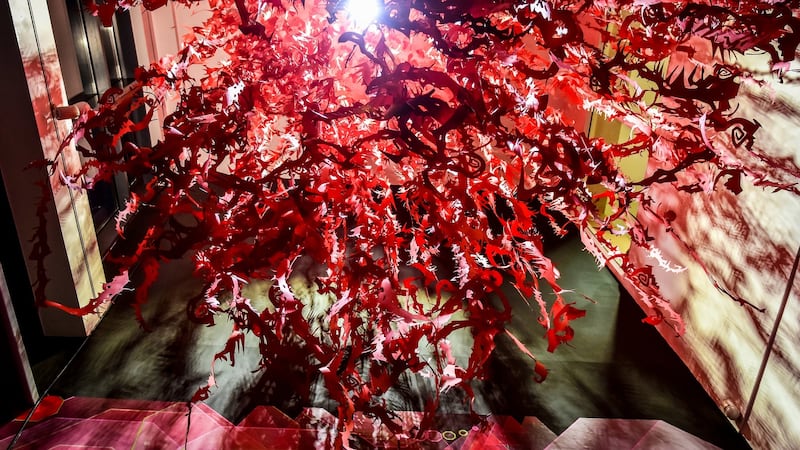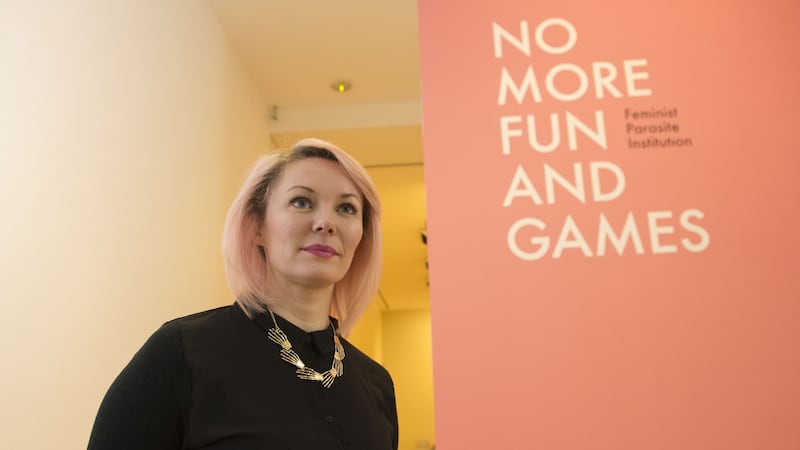In 1986, the US feminist group Guerrilla Girls proclaimed that “It’s even worse in Europe”, referring to the art world’s sexual and racial discrimination. In this assertion, Ireland was no exception.
In 1987, the Douglas Hyde Gallery (DHG) in Dublin mounted a 12-man exhibition called Directions Out which responded to the Troubles and which failed to feature a single work by a woman. The exhibition's curator, Brian McAvera, attempted to defend his selection by writing: "I was very conscious of the need for a woman artist [but] I refuse to bow to tokenism just to satisfy some numerical notion of representation. The blunt fact is that women do not seem to be working in the areas considered by this show." However, the exhibition's primary themes – war and violence – were being explored at the time by women artists such as Rita Duffy and Alice Maher.
Last year, the Guerrilla Girls returned to the subject of their 1986 poster with a project called Is it even worse in Europe? And while their recent exhibition did not incorporate their findings from Project Ireland (2009-2010), a series that exposed Irish museums as "boy crazy", there is ample evidence that the Irish arts and culture sector is still lagging when it comes to representing the work of female artists.


One of the most recent examples is the Abbey Theatre’s “Waking the Nation” programme. Immediately upon its release in 2015 it came under fire for its dearth of work by women. Within two weeks, 600 members of the Irish theatre community had gathered at the Abbey under the “Waking the Feminists” banner to demand equality for women working in the arts. Just like McAvera before him, the Abbey’s then director Fiach Mac Conghail insisted his exclusionary tactics were warranted. “Sometimes plays we have commissioned by and about women just don’t work out,” he said on Twitter. “That has happened. Them the breaks.” It seems it was easier to exclude women almost entirely than to rethink the theatre’s attitudes towards marketing and public engagement.
Equity
Yet the conservative attitude of Ireland’s national theatre begs the question: is there equity in the representation of women in our national cultural institutions?
In 2016, the National Gallery of Ireland held several large-scale historical exhibitions whose cultural, historical and canonical focus tipped the display in the favour of men. Excluding Jackie Nickerson's exhibition Uniform, which concluded within days of the New Year, only one exhibition by a living artist was mounted in 2016, namely Pathos of Distance, Sarah Pierce's exploration of migration and diaspora. And a survey of the National Gallery's recent acquisitions is nothing short of troubling.
In 2016, the gallery acquired 342 new works, 332 of which were by men and the remaining 10 by women. These works were made by 26 artists and only one artist was female. Simply put, men accounted for 99.7 per cent of all acquisitions by the National Gallery of Ireland in 2016.
In the nearby DHG, there were 10 exhibitions held in 2016 and eight of these were solo shows. Only two soloists were women meaning women accounted for one-quarter of the gallery’s solo shows and one-fifth of the gallery’s total exhibitions in 2016.
However, across the city on Parnell Square, Jesse Jones transformed a portion of the Hugh Lane Gallery into a "Feminist Parasite Institution". It challenged the structural sexism of museum collection and curation, and more widely, a history of art that privileges the male sex. Jones's exhibition ran alongside Julie Merriman's Revisions on the first-floor; and if one focuses on the gallery's major first-floor exhibitions, then women accounted for two of five major exhibitions. This number diminishes, however, when the several smaller exhibitions mounted throughout the gallery are taken into account.
Interestingly, the Lab Gallery in Dublin, which specialises in work by young and emerging artists, has a significant track record for showing works by women. Since 2012, women artists have slightly outnumbered their male colleagues and in 2016, women accounted for four of the gallery's seven solo exhibitions. There is no obvious answer for this according to the Lab's curator, Sheena Barrett, but given that the gallery supports recent art graduates and seeing that most recent graduates are female, there may be a correlation, she suggests.
Lastly, the Irish Museum of Modern Art held nine solo exhibitions in 2016: five by women, four of whom are living. The museum also invited feminist art historian Griselda Pollock to give a lecture to coincide with the museum's Carol Rama retrospective. During this lecture, Pollock rebuffed a canon that denies women success during their lifetime then celebrates them posthumously. These posthumous gestures of recognition only serve to perpetuate the marginalisation of female artists and she stressed that such gestures should serve as a cautious reminder for women working today.
Imma’s 2016 programming contradicted this trend, although the museum’s permanent collection echoes the gender inequalities of its fellow institutions. According to a recent survey, 85 per cent of the permanent collection is by male artists – a remarkable statistic for a museum founded in 1991.
Female gatekeepers
Artist Una Walker claimed female representation is higher when the institutional "gatekeepers" are women. One historical example is the Irish Exhibition of Living Art. Brian King became its president in 1972, replacing Norah McGuinness who held the position for almost 30 years. His tenure saw female participation dwindle from 28 in the mid-1960s to three in 1975.
Female representation has been an ongoing point of critical reflection for the Royal Hibernian Academy (RHA). In 2014, RHA secretary Abigail O'Brien said she hoped the RHA would reach a 50-50 gender balance by the gallery's bicentenary in 2023. However, a glance at the annual catalogue shows that the RHA's membership is still dominated by men: 65 per cent of its members are male and it has never had a female president.
Although the 2016 annual exhibition featured 398 artists of which 43 per cent were female (the previous year women accounted for 45 per cent of exhibiting artists), the RHA’s solo exhibitions are also dominated by men. In 2016, 38 per cent of soloists were female (a 10 per cent increase on 2014), while this number stood at 33 per cent in 2015.
Remarkably, this year’s programming is overwhelmingly female with women accounting for 75 per cent of solo exhibitions between January and December. Hopefully this is a precedent that will continue rather than being an unprecedented coincidence.
When the art historian Linda Nochlin asked "Why have there been no great women artists?" she did not ask the question subjectively. "The fault lies not in our stars, our hormones, [or] our menstrual cycles," Nochlin wrote, "but rather in our institutions and education." Some may view this criticism as dated and yet – even today – women are being marginalised from national institutions in the same way they were marginalised from career defining shows in the 1980s.
These statistics are evidence of an ongoing and unchallenged ideological view that engenders art as masculine.
This is so unfortunate. Some of the greatest contemporary art produced in Ireland over the past 30 years has been produced by women. What's more, audiences are engaged by female artists – Amanda Coogan drew an audience of 31,000 to the RHA in 2015 with her six-week show, I'll Sing You a Song from Around the Town.
Certainly, Ireland’s women artists have always been up to the task of making art. That leaves the final undertaking of achieving equal recognition in our country’s institutions. They must actively support current and forthcoming female and minority artists, recognise women’s artistic achievements of the past, and identify their potential and agency within Irish visual culture.
Michelle Doyle works at the Victoria & Albert Museum, in London. This is an edited extract from an essay that will appear in the catalogue for the Royal Hibernian Academy's 187th annual exhibition, which opens on May 23rd; rhagallery.ie












